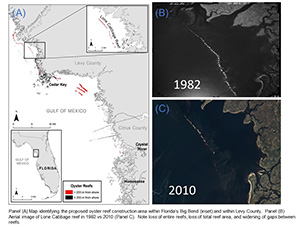
Background and Problem
The Nature Coast - a unique system of estuaries that supports humans.
The Big Bend of Florida is probably the largest stretch of undeveloped coastline in the continental US, and supports natural resources that drive the local economy. The coastline is unique in its extent of rich estuaries, which owe their productivity to the fresh water provided by rivers, particularly the Suwannee. The Big Bend also differs from the rest of Florida in that it depends strongly on natural resources for its economy.


Ecosystem Services from Oyster Reefs

The Big Bend supports large areas of oyster reef habitat and many coastal communities including Cedar Key, Suwannee, Horseshoe Beach and others benefit economically and culturally from healthy oyster reefs. Oyster reefs are known to provide commercial oyster fishing, and also serve as nurseries and essential habitat for fishes harvested by commercial and recreational fishermen. A single oyster can filter 1 - 7 gallons per hour, and an entire reef can markedly improve water quality just through filtration. Oyster reefs also break storm waves and protect valuable marsh and coastal forests, and sometimes homes and harbors.
Offshore reef chains also buffer salinity in the Big Bend estuaries

Many oyster reefs in the Big Bend occur in linear chains parallel to the coast. Recently, we have discovered that offshore chains of reefs oyster reefs act like a leaky dam, helping to slow the movement of freshwater from coastal rivers into the Gulf of Mexico. This is critical for helping to maintain estuarine conditions along the shoreline and create critical nursery habitat for a large number of ecologically and economically important fish and invertebrate species. These reef chains have probably been responsible for the intermediate salinities so crucial to estuaries for a long time, over 3,000 years.
Rapid oyster reef decline
However, even within this largely conserved area known as the "Nature Coast" local oystermen and fishing families have observed marked changes in the oyster resources of this area since the 1970s. Working with the local community for the last ten years, we have conducted research that shows that since the early 1980's oyster reefs in the Big Bend region have declined by 66% with the largest losses (88%) occurring in offshore and nearshore oyster bars that parallel the coastline. Reef chains have become shorter, the gaps between reefs wider, and the elevations are declining by several inches per year. Even worse, once the degrading reefs lose their covering of oyster shells through erosion and burying, they become unstable sandbars where oysters cannot recolonize.
Why did the reefs decline?

Many of the usual stressors for oyster reefs are absent in the Big Bend - overfishing, siltation, pollution, boat wakes, anoxia, and disease are all largely excluded as explanations for the decline. Instead, our research over the last ten years has led us to conclude that a decrease in freshwater flow from the mainland is the most likely culprit. When freshwater flow is low, salinities increase, and oysters become very vulnerable to predation and parasitic diseases. During the same period as the decline there has been a reduction in freshwater deliveries from the Suwannee River, and probably from other coastal rivers as well. These reductions in flow are the result of increasing human water use upstream.
How do we make reefs resilient to lower freshwater discharges?
The most obvious problem is reduced freshwater flow, and our partners in the Suwannee River Water Management District are working hard to conserve water through a variety of projects that should positively affect freshwater flows.
But while we are waiting for more water, the oysters need help. Once the reefs have lost their shell covering, they cannot re-form because young oysters cannot attach and survive on the remaining sandy surface. In addition, the lower the reef, the less freshwater is retained and the worse it is for the oysters - a nasty feedback. The reef clearly needs a durable surface that will create good settlement environment for young oysters during both good times and bad. Further, the reef needs to be brought back up to the right elevation so it retains fresh water to the extent it once did. Once established, a healthy, durable reef will be more resilient to fluctuations in climate and water flow. Since oysters can grow vertically faster than sea level can rise, such a reef is largely self-sustaining.


